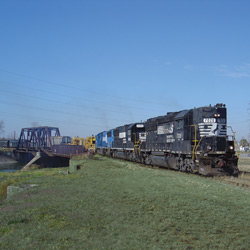Railroads and Peoria

Peoria incorporated as a town in 1835 and became a city a decade later. By 1850, the city of more than 5,000 residents bustled with industry such as breweries, distilleries, flour mills and meat packers. Naturally, growing population and industry attracted interest from the railroads.
The first to arrive, the Peoria & Bureau Valley, began service on November 7, 1854. A quarter century later, Peoria could boast ten railroads, but a tangled network of track, along with its natural consequences of congestion, sabotage, and court injunctions begged for change.
The solution came with the Peoria & Pekin Union Railway, formed by four of the city’s railroads in 1880. The P&PU replaced its owners’ inefficient and duplicative service to the city’s industries and constructed modern yard and locomotive servicing facilities. The new carrier completed Union Station in 1882.
Expanded yard capacity attracted more industry and railroads to the city. By 1900, a dozen railroads served Peoria, but the city had run out of room, so businessmen purchased land across the river in present-day East Peoria to entice continued industrial growth.
As more new railroads arrived (the last in 1907), the city’s importance grew as an alternative gateway for shippers desiring to bypass Chicago’s congested yards. By 1906, the P&PU handled over one million cars annually. To ensure sufficient capacity for future growth, the railroad placed a large new yard into service in East Peoria the following year.
But storm clouds had gathered in the form of increased regulation governing freight rates, and in a short time, there would be serious competition from buses and trucks. As Americans shifted their travel to the paved, two-lane highways that crisscrossed the nation, railroads reduced their schedules. One railroad left the passenger business completely in 1924, and the P&PU dropped its Peoria-Pekin suburban service in 1931. The Great Depression only accelerated the decline in passenger service, and several lines had become freight-only by the time of World War Two.
Despite the depressed 1930s, Peoria contributed a growing volume of freight business to its railroads. Public works projects spurred the expansion of factories that produced heavy construction machinery. The end of Prohibition revived distilleries and breweries. Following the war, the railroad industry had to deal with rapidly rising costs and competitive pressures from truck lines, which increased with construction of the interstate highway system. As a result, railroads could no longer take for granted their share of passenger and freight business. Instead, they had to fight for it.
Peoria’s own Toledo Peoria & Western purchased hundreds of acres of land in East Peoria and Mapleton to which numerous manufacturers and warehouse firms located during the 1950s and ‘60s. Other railroads benefited as the area’s largest industrial employers expanded, modernized and constructed new facilities in the area.
Dieselization, larger capacity freight cars, piggyback and container service, single-commodity “unit trains,” automated railroad yards and computerization helped railroads fight the erosion of traffic. Unfortunately, some of these innovations led to the decline of the so-called “Peoria Gateway.”
Most railroads dieselized their trains by the end of the 1950s, allowing more efficient freight interchange at places like Chicago. The movement of time-sensitive freight such as perishables, meat and livestock increasingly shifted to the highways, and the completion of long stretches of interstate highways by 1970 increased truckers’ productivity and thus their ability to siphon business from the rails. Mergers reduced the number of independent railroads serving the Peoria-Pekin metro area from fourteen in 1960 to eleven in 1972. Bankruptcies brought future uncertainty, and threatened nationalization.
By 1960, all lines to Peoria, save for the Chicago Rock Island & Pacific, had become freight-only. Back then, the twice-daily Peoria Rocket still attracted good patronage to and from Chicago, but that would change with the increasing affordability and acceptance of commercial airline travel. The United States Postal Service’s decision to divert virtually all mail away from the rails made passenger trains unprofitable, and service to Chicago was cut in half in 1968. The remaining train soldiered on for another decade, making its last run on New Year’s Eve, 1978. Amtrak did operate a daily Chicago-East Peoria train, but Peorians had long been out of the habit of riding the rails, and the service died after a 14-month trial in 1980-1981.
The liquidation of the bankrupt Rock Island Railroad beginning in 1980, subsequent mergers and closures and cutbacks by the area’s major industrial employers further eroded Peoria’s status as a railroad town. Simultaneously, however, the Staggers Act freed the railroad industry from nearly a century of suffocating regulatory shackles. Signed into law in 1980, the act partially deregulated the railroads, allowing them to price their services based on market forces and abandon or sell unprofitable parts of their route systems. That action initially hurt Peoria, as several area rail lines were abandoned during the 1980s, but it helped to strengthen those that remained.
Peoria lost its status as “third-largest rail gateway in the Midwest,” but remains an important interchange point for coal trains and has developed into a major rail-to-barge and barge-to-rail transfer point for bulk commodities. Today, the Peoria-Pekin area remains a major manufacturing center and boasts service from eleven railroad companies. iBi

